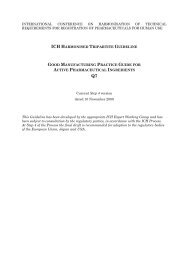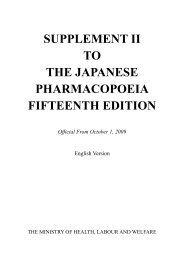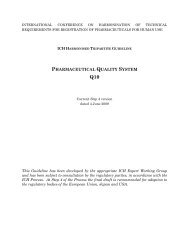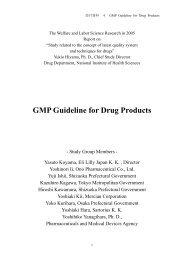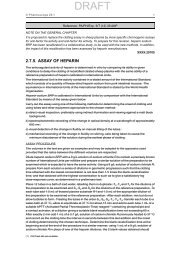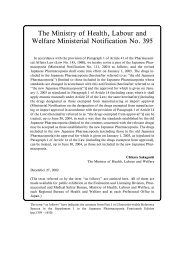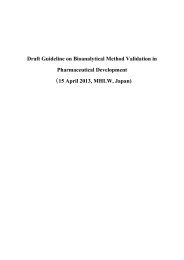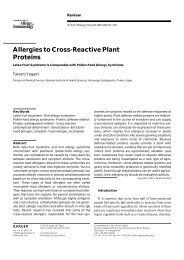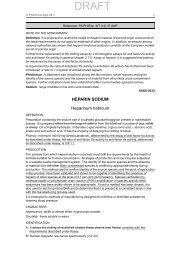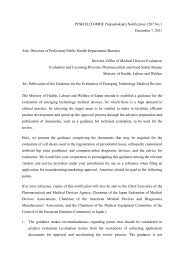Survey of Volatile Organic Compounds found in Indoor and ... - NIHS
Survey of Volatile Organic Compounds found in Indoor and ... - NIHS
Survey of Volatile Organic Compounds found in Indoor and ... - NIHS
Create successful ePaper yourself
Turn your PDF publications into a flip-book with our unique Google optimized e-Paper software.
<strong>Survey</strong> <strong>of</strong> <strong>Volatile</strong> <strong>Organic</strong> <strong>Compounds</strong> <strong>found</strong> <strong>in</strong> <strong>Indoor</strong> <strong>and</strong> Outdoor Air Samples from Japan<br />
Bull. Natl. Inst. Health Sci., 123<br />
<br />
Notes<br />
<strong>Survey</strong> <strong>of</strong> <strong>Volatile</strong> <strong>Organic</strong> <strong>Compounds</strong> <strong>found</strong> <strong>in</strong> <strong>Indoor</strong> <strong>and</strong><br />
Outdoor Air Samples from Japan<br />
Toshiko Tanaka-Kagawa 1 , Shigehisa Uchiyama 1 , Erika Matsushima 1 , Akira Sasaki 2 ,<br />
Hiroshi Kobayashi 3 , Hiromi Kobayashi 4 , Masahiro Yagi 5 , Masahiko Tsuno 6 ,<br />
Masa Arao 6 , Kazumi Ikemoto 6 , Makoto Yamasaki 7 , Ayako Nakashima 7 , Yuri Shimizu 7 ,<br />
Yasufumi Otsubo 8 , Masanori Ando 9 , Hideto J<strong>in</strong>no 1# <strong>and</strong> Hiroshi Tokunaga 1<br />
<br />
<br />
<br />
<br />
<br />
<br />
<br />
<br />
<br />
<br />
<br />
m <br />
<br />
a<br />
<br />
m <br />
<br />
<br />
<br />
<br />
<br />
Introduction<br />
<strong>Indoor</strong> air quality is <strong>of</strong> grow<strong>in</strong>g concern, ma<strong>in</strong>ly<br />
because <strong>of</strong> the <strong>in</strong>creased <strong>in</strong>cidence <strong>of</strong> sick build<strong>in</strong>g<br />
syndrome <strong>and</strong> build<strong>in</strong>g related illness 1,2 . To achieve <strong>and</strong><br />
ma<strong>in</strong>ta<strong>in</strong> healthy air quality, the M<strong>in</strong>istry <strong>of</strong> Health,<br />
Labour <strong>and</strong> Welfare <strong>of</strong> Japan (MHLW) has established<br />
guidel<strong>in</strong>es for 13 organic compounds <strong>in</strong> <strong>in</strong>door air,<br />
<strong>in</strong>clud<strong>in</strong>g formaldehyde (guidel<strong>in</strong>e value, 100 mg/m 3 ),<br />
acetaldehyde (48 mg/m 3 ), tetradecane (330 mg/m 3 ),<br />
toluene (260 mg/m 3 ), xylene (870 mg/m 3 ), ethylbenzene<br />
(3,800 mg/m 3 ), styrene (220 mg/m 3 ), 1,4-dichlorobenzene<br />
(240 mg/m 3 ), chlorpyrifos (1 mg/m 3 ), diaz<strong>in</strong>on (0.29<br />
# To whom correspondence should be addressed: Hideto J<strong>in</strong>no; 1-<br />
18-1 Kamiyoga, Setagya-ku, Tokyo 158-8501, Japan; Tel: +81-3-<br />
3700-9298; Fax: +81-3-3700-9298; E-mail: j<strong>in</strong>no@nihs.go.jp<br />
mg/m 3 ), fenobucarb (33 mg/m 3 ), di-(2-ethylhexyl)<br />
phthalate (120 mg/m 3 ) <strong>and</strong> di-(n-butyl) phthalate (220<br />
mg/m 3 ) (http://www.nihs.go.jp/mhlw/chemical/situnai/<br />
kentoukai/rep-eng4.html). There have been several<br />
pioneer<strong>in</strong>g reports on the <strong>in</strong>door air concentrations for<br />
these compounds 3 5 . In addition to the guidel<strong>in</strong>es for<br />
each compound, the MHLW has proposed total volatile<br />
organic compounds (TVOC) <strong>of</strong> 400 mg/m 3 as an advisable<br />
value based on the concept <strong>of</strong> As Low As Reasonably<br />
Achievable from the <strong>in</strong>vestigations on the <strong>in</strong>door VOC<br />
concentrations <strong>in</strong> Japan. The analytical procedure <strong>of</strong><br />
TVOC, however, has not been fully def<strong>in</strong>ed. For <strong>in</strong>stance,<br />
the list <strong>of</strong> target compounds, or the VOCs which should<br />
be identified <strong>and</strong> quantified <strong>in</strong> the TVOC analysis,<br />
rema<strong>in</strong>s to be established. Furthermore, it will be<br />
necessary to ref<strong>in</strong>e the air sampl<strong>in</strong>g method (e.g. an
123 2005<br />
alternative sorbent to Tenax TA, change the air sampl<strong>in</strong>g<br />
volume/rate) for the quantitative analysis <strong>of</strong> TVOC.<br />
In this study, we <strong>in</strong>vestigated the 132 VOCs <strong>in</strong> the 50<br />
<strong>in</strong>door <strong>and</strong> outdoor air samples by the thermal desorptiongas<br />
chromatography/mass spectrometry (TD-GC/MS)<br />
method. The data is critical for def<strong>in</strong><strong>in</strong>g the c<strong>and</strong>idate<br />
compounds to be <strong>in</strong>cluded <strong>in</strong> the target compound list for<br />
Japan.<br />
Materials <strong>and</strong> methods<br />
Reagents<br />
All the analytical st<strong>and</strong>ards, listed <strong>in</strong> Table 1, were<br />
obta<strong>in</strong>ed from Wako Pure Chemicals (Osaka, Japan).<br />
Air sampl<strong>in</strong>g<br />
The residences used <strong>in</strong> this <strong>in</strong>vestigation were chosen<br />
without consideration <strong>of</strong> the age <strong>of</strong> the houses. The<br />
<strong>Indoor</strong> <strong>and</strong> outdoor air samples were collected from 50<br />
residences <strong>in</strong> Iwate, Yamanashi, Shiga, Hyogo, Kochi <strong>and</strong><br />
Fukuoka Prefectures <strong>in</strong> January <strong>and</strong> February, 2005.<br />
Active sampl<strong>in</strong>g was carried out for 24 h at a flow rate <strong>of</strong><br />
5 ml/m<strong>in</strong>, us<strong>in</strong>g a five-l<strong>in</strong>e mass flow controller (Toyo<br />
Riko, Tokyo, Japan) <strong>and</strong> a vacuum pump L<strong>in</strong>icon LV-140<br />
(Nitto Koki, Tokyo, Japan). Typical sample volumes <strong>of</strong> 7.2<br />
L were passed through the <strong>in</strong>-house-made 4-bed sorbent<br />
tube (3 graphitized carbon sorbents <strong>and</strong> one carbon<br />
molecular sieve). The sorbent tubes were preconditioned<br />
us<strong>in</strong>g a Markes TC-20 (ENV Science Trad<strong>in</strong>g, Chiba,<br />
Japan) at 310 for 24 h with a stream <strong>of</strong> 20 ml/m<strong>in</strong><br />
helium.<br />
TD-GC/MS analysis <strong>of</strong> 132 VOCs<br />
All the TD-GC/MS analysis was carried out at Green<br />
Blue Corporation (Tokyo, Japan) <strong>and</strong> a detailed method<br />
will be published elsewhere (Ando. et al., unpublished<br />
results). Briefly, analyses were performed us<strong>in</strong>g a QP-<br />
5050A GC/MS (Shimadzu, Kyoto, Japan) equipped with a<br />
thermal desorption unit ATD-400 (Perk<strong>in</strong>-Elmer,<br />
Yokohama, Japan). Thermal desorption was carried out<br />
by heat<strong>in</strong>g the tube at 300 for 20 m<strong>in</strong> <strong>and</strong> apply<strong>in</strong>g a<br />
stream <strong>of</strong> helium <strong>of</strong> 20 ml/m<strong>in</strong>. The analytes were<br />
subsequently focused at 10 on a Tenax TA trap, <strong>and</strong><br />
then the trap was heated at 300 for 2 m<strong>in</strong>. The outlet<br />
splitter <strong>of</strong> the unit was fixed at 1:19. The column used was<br />
a CP-SIL 5CB fused silica capillary, 60 m0.25 mm 1.0<br />
mm film thickness (Varian, Palo Alto, CA, USA). The oven<br />
<strong>of</strong> the chromatograph was programmed from 40 (hold<br />
10 m<strong>in</strong>) to 140 at 3 /m<strong>in</strong>, to 200 at 5 /m<strong>in</strong> <strong>and</strong><br />
f<strong>in</strong>ally up to 300 at 10/m<strong>in</strong>. The carrier gas was high<br />
purity helium at a flow rate <strong>of</strong> 1 ml/m<strong>in</strong>.<br />
Results <strong>and</strong> discussion<br />
<strong>Indoor</strong> <strong>and</strong> outdoor air samples were collected from 50<br />
different residences <strong>in</strong> January - February, 2005, <strong>and</strong> their<br />
VOC constituents were analyzed by the TD-GC/MS<br />
method. Table 1 summarizes the <strong>in</strong>door <strong>and</strong> outdoor air<br />
concentrations for 132 VOCs. When compared <strong>in</strong> terms<br />
<strong>of</strong> the median values, the most abundant VOCs were<br />
ethanol (520 mg/m 3 ), followed by acetone (16 mg/m 3 ),<br />
toluene (14 mg/m 3 ), limonene (13 mg/m 3 ), n-nonane (6.8<br />
mg/m 3 ), n-decane (6.4 mg/m 3 ), m,p-xylene (6.1 mg/m 3 ),<br />
n-undecane (5.5 mg/m 3 ), n-dodecane (4.4 mg/m 3 ),<br />
2-propanol (3.8 mg/m 3 ) <strong>and</strong> n-octane (3.7 mg/m 3 ). In<br />
addition to the ubiquitously detected compounds <strong>in</strong><br />
<strong>in</strong>door air (ethanol, n-undecane, acetone, naphthalene <strong>and</strong><br />
benzene), VOCs that <strong>found</strong> with high frequencies ( 80%)<br />
were n-alkanes (C7 to C16), branched-cha<strong>in</strong> alkanes (C7<br />
to C10), cycloalkanes (cyclohexane, methylcyclopentane<br />
<strong>and</strong> methylcyclohexane), alkylbenzenes (toluene, xylene<br />
isomers, ethylbenzene, n-propylbenzene, 2-ethyltoluene,<br />
trimethylbenzene isomers <strong>and</strong> 1,2,4,5-tetramethylbenzene),<br />
terpenes (limonene <strong>and</strong> a-p<strong>in</strong>ene), halocarbons<br />
(dichloromethane, chlor<strong>of</strong>orm, carbon tetrachloride,<br />
1,4-dichlorobenzene <strong>and</strong> 1,3,5-trichlorobenzene), styrene,<br />
2-propanol, ethylacetate <strong>and</strong> methylisobutylketone. Among<br />
each VOC <strong>in</strong>cluded <strong>in</strong> the guidel<strong>in</strong>e for <strong>in</strong>door air quality<br />
<strong>in</strong> Japan, only 1,4-dichlorobenzene was <strong>found</strong> at the<br />
concentrations exceed<strong>in</strong>g the guidel<strong>in</strong>e value (240 mg/m 3 ):<br />
two residences at the levels <strong>of</strong> 320 <strong>and</strong> 360 mg/m 3 .<br />
In terms <strong>of</strong> the sum <strong>of</strong> each VOC, 15 <strong>of</strong> 50 residences<br />
(30%) exceeded the provisional guidel<strong>in</strong>e value for TVOC<br />
(400 mg/m 3 ) (Fig.1). Figure 2 depicts the composition <strong>of</strong><br />
each chemical class for these 15 <strong>in</strong>door air samples. For<br />
residence A, l<strong>in</strong>ear <strong>and</strong> branched-cha<strong>in</strong> alkanes accounted<br />
for 70% <strong>of</strong> the <strong>in</strong>door VOCs. These compounds were also<br />
a major component for residences D, F, I, J, K, L <strong>and</strong> M<br />
(35-55%). The alkanes were probably derived from fossil<br />
fuels because all <strong>of</strong> these residences used unvented<br />
kerosene heaters dur<strong>in</strong>g the air sampl<strong>in</strong>g procedure. The<br />
predom<strong>in</strong>ant VOC detected <strong>in</strong> residences B <strong>and</strong> N was<br />
1,4-dichlorobenzene (27% <strong>and</strong> 39%, respectively). This<br />
moth repellent was also abundant <strong>in</strong> the <strong>in</strong>door air sample<br />
from F (31%), <strong>and</strong> thus alkanes <strong>and</strong> 1,4-dichlorobenzene<br />
represented almost 75% <strong>of</strong> the comb<strong>in</strong>ed VOCs. Terpenes<br />
were major constituents (54-84%) <strong>of</strong> the <strong>in</strong>door air<br />
samples from residences C, E, G <strong>and</strong> O, although the
<strong>Survey</strong> <strong>of</strong> <strong>Volatile</strong> <strong>Organic</strong> <strong>Compounds</strong> <strong>found</strong> <strong>in</strong> <strong>Indoor</strong> <strong>and</strong> Outdoor Air Samples from Japan
123 2005
<strong>Survey</strong> <strong>of</strong> <strong>Volatile</strong> <strong>Organic</strong> <strong>Compounds</strong> <strong>found</strong> <strong>in</strong> <strong>Indoor</strong> <strong>and</strong> Outdoor Air Samples from Japan<br />
<br />
Fig. 1 Frequency distribution <strong>of</strong> the sum <strong>of</strong> <strong>in</strong>door air VOCs. The<br />
oblique bars <strong>in</strong>dicate those data exceed<strong>in</strong>g the provisional<br />
guidel<strong>in</strong>e value for TVOC.<br />
most abundant terpene did vary: -p<strong>in</strong>ene for C, E <strong>and</strong> G<br />
<strong>and</strong> limonene for O. Interest<strong>in</strong>gly, residences C, E <strong>and</strong> G<br />
were less than one-year old at the time <strong>of</strong> air sampl<strong>in</strong>g.<br />
Therefore, the rather high concentrations <strong>of</strong> -p<strong>in</strong>ene<br />
might be attributable to emission from the woody build<strong>in</strong>g<br />
materials. In contrast, residence O was a ten-year old<br />
build<strong>in</strong>g, <strong>and</strong> the high limonene concentration was not<br />
associated with elevated levels <strong>of</strong> other terpenes. We<br />
believe the limonene detected <strong>in</strong> residence O might be<br />
derived from aroma products. F<strong>in</strong>ally, residence H was<br />
primarily polluted with 1,1,1,2-tetrafluoroethane (74%),<br />
suggest<strong>in</strong>g accidental leakage from a household appliance<br />
such as a refrigerator.<br />
In conclusion, we have analyzed 132 VOCs <strong>in</strong> <strong>in</strong>door<br />
<strong>and</strong> outdoor air samples collected from 50 residences <strong>in</strong><br />
Japan, <strong>and</strong> identified the most abundant chemical classes<br />
(i.e. l<strong>in</strong>ear <strong>and</strong> branched-cha<strong>in</strong> alkanes, alkylbenzenes <strong>and</strong><br />
terpenes). The results presented here are important <strong>in</strong><br />
establish<strong>in</strong>g the target compound list for TVOC analysis<br />
<strong>in</strong> Japan, as well as assess<strong>in</strong>g the current status <strong>of</strong> <strong>in</strong>door<br />
air quality.<br />
Acknowledgments<br />
This study was f<strong>in</strong>ancially supported by the MHLW <strong>of</strong><br />
Japan. The authors would like to thank Ms. Yumiko<br />
Nomura, Pharmaceutical <strong>and</strong> Food Safety Bureau <strong>of</strong> the<br />
MHLW for her <strong>in</strong>sightful discussion on this survey.<br />
References<br />
1 Ando, M.: Bull. Natl. Inst. Health Sci., 120, 6-38 (2002)<br />
2 Saijo, Y., Kishi, R., Sata, F., Katakura, Y., Urashima,<br />
Y., Hatakeyama, A., Kobayashi, S., J<strong>in</strong>, K., Kurahashi,<br />
N., Kondo, T., Gong, Y. Y. <strong>and</strong> Umemura, T.: Int.<br />
Arch. Occup. Environ. Health, 77, 461-470 (2004)<br />
3 Sakai, K., Norback, D., Mi, Y., Shibata, E., Kamijima,<br />
M., Yamada, T. <strong>and</strong> Takeuchi, Y.: Environ. Res., 94,<br />
75-85 (2004)<br />
4 Sakaguchi, J. <strong>and</strong> Akabayashi, S.: <strong>Indoor</strong> Air, 13<br />
(Suppl 6), 42-49 (2003)<br />
5 M<strong>in</strong>ami, T., Matsumoto, H., Kondo, F., Yamada, S.,<br />
Matsumura, T., Ando, M. <strong>and</strong> Miyazaki, Y.: Jpn. J.<br />
Pub. Health, 49, 211-221 (2002)<br />
Fig. 2<br />
Chemical classes <strong>of</strong> the VOCs for the samples that exceeded the provisional guidel<strong>in</strong>e value for TVOC.



